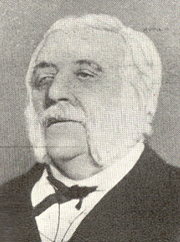
Dessert is a course that concludes a meal. The course consists of sweet foods, such as cake, biscuit, ice cream and possibly a beverage such as dessert wine and liqueur. Some cultures sweeten foods that are more commonly savory to create desserts. In some parts of the world there is no tradition of a dessert course to conclude a meal.

Gelatin desserts are desserts made with a sweetened and flavoured processed collagen product (gelatin), which makes the dessert "set" from a liquid to a soft elastic solid gel. This kind of dessert was first recorded as "jelly" by Hannah Glasse in her 18th-century book The Art of Cookery, appearing in a layer of trifle. Jelly recipes are included in the 19th-century cookbooks of English food writers Eliza Acton and Mrs Beeton.

Jell-O, stylised as JELL-O, is an American brand offering a variety of powdered gelatin dessert, pudding, and no-bake cream pie mixes. The original gelatin dessert is the signature of the brand. "Jell-O" is a registered trademark of Kraft Heinz, and is based in Chicago, Illinois.

Guar gum, also called guaran, is a galactomannan polysaccharide extracted from guar beans that has thickening and stabilizing properties useful in food, feed, and industrial applications. The guar seeds are mechanically dehusked, hydrated, milled and screened according to application. It is typically produced as a free-flowing, off-white powder.

Custard is a variety of culinary preparations based on sweetened milk, cheese, or cream cooked with egg or egg yolk to thicken it, and sometimes also flour, corn starch, or gelatin. Depending on the recipe, custard may vary in consistency from a thin pouring sauce to the thick pastry cream used to fill éclairs. The most common custards are used in custard desserts or dessert sauces and typically include sugar and vanilla; however, savory custards are also found, e.g., in quiche.

Pudding is a type of food. It can be either a dessert, served after the main meal, or a savoury dish, served as part of the main meal.

Crème anglaise, custard sauce, pouring custard, or simply custard is a light, sweetened pouring custard from French cuisine, used as a dessert cream or sauce. It is a mix of sugar, egg yolks, and hot milk usually flavoured with vanilla.

Alfred Bird was an English food manufacturer and chemist. He was born in Nympsfield, Gloucestershire, England in 1811 and was later a pupil at King Edward's School, Birmingham. He was the inventor of a series of food products, most notably egg-free custard and baking powder. His father was a lecturer in astronomy at Eton College. His son Alfred Frederick Bird continued to develop the business after his father's death.

Chocolate puddings are a class of desserts in the pudding family with chocolate flavors. There are two main types: a boiled then chilled dessert, texturally a custard set with starch, commonly eaten in the U.S., Canada, Germany, Sweden, Poland, and East and South East Asia; and a steamed/baked version, texturally similar to cake, popular in the UK, Ireland, Australia, Germany and New Zealand.

Angel Delight is a powdered dessert mix produced in the United Kingdom. It is designed to be whisked with milk to create a sweet mousse-like dessert.

A thickening agent or thickener is a substance which can increase the viscosity of a liquid without substantially changing its other properties. Edible thickeners are commonly used to thicken sauces, soups, and puddings without altering their taste; thickeners are also used in paints, inks, explosives, and cosmetics.

Premier Foods plc is a British food manufacturer headquartered in St Albans, Hertfordshire. The group owns many well-known brands, including Mr Kipling, Ambrosia, Bird's Custard, Angel Delight, Homepride cooking sauces, Lyons, Sharwood's, Loyd Grossman sauces, Oxo, Bisto, Batchelors and Plantastic. Premier Foods also produce cakes under the Cadbury's name, using the brand under licence. It is listed on the London Stock Exchange and is a constituent of the FTSE 250 Index.
Custard is food based on sweetened milk, cheese, or cream cooked with egg or egg yolk.

Sir Alfred Frederick Bird, 1st Baronet was an English chemist, food manufacturer and Conservative Party politician. He is best remembered as the proprietor of Alfred Bird & Sons, a company founded by his father Alfred Bird, the inventor of baking powder and the powdered custard that bears his name.

Sponge cake is a light cake made with eggs, flour and sugar, sometimes leavened with baking powder. Some sponge cakes do not contain egg yolks, like angel food cake, but most of them do. Sponge cakes, leavened with beaten eggs, originated during the Renaissance, possibly in Spain. The sponge cake is thought to be one of the first non-yeasted cakes, and the earliest attested sponge cake recipe in English is found in a book by the English poet Gervase Markham, The English Huswife, Containing the Inward and Outward Virtues Which Ought to Be in a Complete Woman (1615). Still, the cake was much more like a cracker: thin and crispy. Sponge cakes became the cake recognised today when bakers started using beaten eggs as a rising agent in the mid-18th century. The Victorian creation of baking powder by English food manufacturer Alfred Bird in 1843 allowed the addition of butter to the traditional sponge recipe, resulting in the creation of the Victoria sponge. Cakes are available in many flavours and have many recipes as well. Sponge cakes have become snack cakes via the Twinkie.

Instant pudding is an instant food product that is manufactured in a powder form and used to create puddings and pie filling. It is produced using sugar, flavoring agents and thickeners as primary ingredients. Instant pudding can be used in some baked goods.

Chivers is an Irish brand of jams and preserves. For a large part of the 20th century Chivers and Sons was Britain's leading preserves manufacturer. However, the brand is currently owned by the Boyne Valley Group who make a range of preserves using the Chivers name.

















